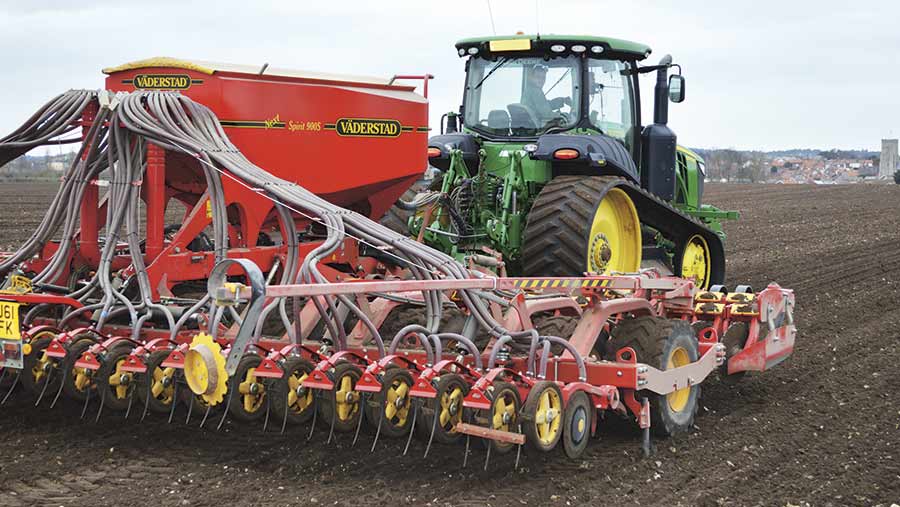7-step guide to growing quality malting barley
 Drilling spring barley.
Drilling spring barley. Good price premiums and a desire to control blackgrass is leading to increased interest in malting spring barley, with the UK climate well suited to producing top-notch samples.
Here is his seven-step guide to help maximise yields and achieve the quality required by maltsters:
See also: Two varieties lead spring barley drilling season
1. Variety selection
Achieving the full premium is the aim of the game if spring barley is going to reach its potential.
If growing it for the first time or if it’s on land that is not a natural fit for the crop – usually if the soil is on the heavier side – the grower needs to work closely with traders.
They know where they can place the crop and what potential contingencies they can offer if the produce is out of contract specification.
Having a backup plan is critical to make the most of any quality and avoid unnecessary claims.
Variety selection is key for balancing the required quality with agronomic risk. Popular choices include Planet, Laureate, Irina, Sassy, Propino and Concerto, as well as the niche varieties for specific markets.
It may be worth looking at varieties with high brackling resistance, such as Irina (9). This can help prevent header losses at harvest and protect the germination percentage.
2. Seedbed preparation
Spring crops have a much smaller growing window in which to achieve final yield, thus everything that can be done to improve growth will have a positive effect on profit margins.
Traditionally, land is ploughed ahead of spring barley in time to let winter weather make 80% of the seedbed, with ideally only one pass with a cultivator in the spring ahead of drilling.
Non-plough and direct seeding techniques work, but headlands have to be in good order, and growers need to consider the residues of the previous crop and to minimise the risks of volunteer cereals.
Cover cropping ahead of spring barley is successful if the cover crop is destroyed early and soil structure maintained through to drilling – for this reason it’s not a fit for all fields.
3. Drilling and seed rate
Spring barley is typically sown from December until late April, with the germination rate dependent on moisture and soil temperature.
Avoid working to a calendar date which can result in drilling into sub-optimal conditions where the soil can be cold and cloddy. On high-clay soils, spring barley establishment can vary from 55% for early drilling to 70% for late drilling.
As heavy soils take longer to warm in the spring, growers need to be willing to delay drilling and increase seed rates. If sown into fine and well-drained seedbeds, growers can expect an 80-95% establishment rate.
A target plant population for February/March is 250-300 plants/sq m. The seed rate required to achieve this will depend on thousand grain weight but typically ranges from 350-450 seeds/sq m.
Seed should have a 95%-plus germination rate, with any home-saved seed tested.
4. Pre-emergence herbicides
Spring barley is a competitive crop, but it is important to achieve good weed control as it will benefit grain quality and ease of harvest.
Following a pre-drill glyphosate application, a range of residual pre-emergence sprays, based on flufenacet, diflufencian and pendimethalin, can be used to control broadleave and grassweeds.
Conditions are often dry, which can compromise grassweed control. If this is the case, then the grassier fields can be drilled last.
Spring barley will not tolerate a high rate of pre-emergence herbicides, especially if the seedbed is less than ideal. It is best to back off rates if unsure and rely on rapid crop cover.
5. Fertiliser
It is critical with spring barley to consider previous crops, farmyard manure applications and the soil nitrogen supply to ensure grain nitrogen requirements are met.
Where no organic manure is applied, crops will receive 100-160 kg/ha of nitrogen, usually half applied to the seedbed and the remainder prior to the crop tillering.
Many growers apply all their nitrogen in one application, which can work perfectly well. Late nitrogen uptake either due to late rainfall or delayed/too high last dose can take grain nitrogen out of specification.
Nitrogen rates have to be guided by yield potential, anticipated spring rainfall and historic grain nitrogen content, and for this reason rates and timings are specific to farms and should be tweaked in season.
6. Marketing
As the area of spring barley grown increases, growing a crop speculatively becomes even more risky, with crops facing the prospect of having to be sold into the feed market.
Lock into a premium on a proportion of the crop and then grow to meet the specific requirements of that market. Ensure there are fallbacks on any contract if the crop does not fulfil quality.
7. Harvest and storage
Prioritise the harvesting of malting varieties over feed wheat in good conditions when both grain and straw are mature.
Drying and storage is crucial to preserve high seed germination. If using drying floors, grain should be dried to 14% within 10 days of harvest to prevent reductions in germination and mould formation.
If using hot air driers, grain temperature should not rise above 50C as this can decrease germination.
Malting barley quality requirements:
- 64kg/hl specific weight
- below 1.85% grain nitrogen
- below 2% admixture
- above 98% germination

